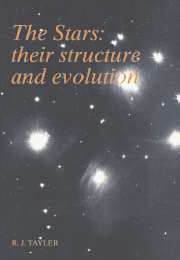Book contents
- Frontmatter
- Contents
- Preface
- Symbols
- Numerical values
- 1 Introduction
- 2 Observational properties of stars
- 3 The equations of stellar structure
- 4 The physics of stellar interiors
- 5 The structure of main sequence stars and pre-main-sequence evolution
- 6 Early post-main-sequence evolution and the ages of star clusters
- 7 Mass loss from stars
- 8 Close binary stars
- 9 Advanced evolutionary phases
- 10 The final stages of stellar evolution: white dwarfs, brown dwarfs, neutron stars and black holes
- 11 Concluding remarks
- Appendix 1 Thermodynamic equilibrium
- Appendix 2 The equation of radiative transfer
- Appendix 3 The pressure of a degenerate gas
- Suggestions for further reading
- Index
11 - Concluding remarks
Published online by Cambridge University Press: 05 June 2012
- Frontmatter
- Contents
- Preface
- Symbols
- Numerical values
- 1 Introduction
- 2 Observational properties of stars
- 3 The equations of stellar structure
- 4 The physics of stellar interiors
- 5 The structure of main sequence stars and pre-main-sequence evolution
- 6 Early post-main-sequence evolution and the ages of star clusters
- 7 Mass loss from stars
- 8 Close binary stars
- 9 Advanced evolutionary phases
- 10 The final stages of stellar evolution: white dwarfs, brown dwarfs, neutron stars and black holes
- 11 Concluding remarks
- Appendix 1 Thermodynamic equilibrium
- Appendix 2 The equation of radiative transfer
- Appendix 3 The pressure of a degenerate gas
- Suggestions for further reading
- Index
Summary
In this book I have described the methods used in the theoretical study of stellar structure and evolution and I have discussed many of the results obtained. I have tried to discuss the present state of a developing subject and to mention the main uncertainties. As I have stressed, particularly at the end of Chapter 9, some of the detailed theoretical ideas may prove to be wrong, but it is confidently expected that the broad outline of the subject as presented in Chapters 3–5 is correct. In this chapter I discuss further some of the points where important uncertainties remain.
In the first place it is important to realise that, although this book has been written by a theoretical astrophysicist, who has a particular interest in obtaining a theoretical understanding of the subject, ultimately all of the theoretical work must be related to observations. This has a twofold implication. The theoretical worker must keep the observational results in mind and there is a continuing need for new observations. The subject depends considerably on some of the less glamorous parts of observational astronomy. In these days of quasars, pulsars and the cosmic microwave radiation, the work of measuring parallaxes and proper motions and studying the orbits of binary star systems is often regarded as being very humdrum. However, it is vitally important in supplementing the information possessed about such things as masses, radii and absolute magnitudes.
- Type
- Chapter
- Information
- The StarsTheir Structure and Evolution, pp. 220 - 224Publisher: Cambridge University PressPrint publication year: 1994



